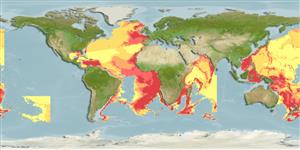Teleostei (teleosts) >
Gadiformes (Cods) >
Macrouridae (Grenadiers or rattails)
Etymology: Cetonurus: Greek, ketos = a marine monster, whale + Greek, oura = tail (Ref. 45335).
More on author: Vaillant.
Environment: milieu / climate zone / depth range / distribution range
Ecology
Marine; bathypelagic; depth range 860 - 4621 m (Ref. 11953), usually 1000 - 2000 m (Ref. 3587). Deep-water
Atlantic and Pacific: Eastern Atlantic: Bay of Biscay, Azores, off Mauritania, Senegal, and Canary Islands, Western Atlantic: Gulf of Mexico, east Caribbean. Western Pacific: Off Japan and Indonesia.
Size / Weight / Age
Maturity: Lm ? range ? - ? cm
Max length : 50.0 cm TL male/unsexed; (Ref. 3587)
Dorsal soft rays (total): 9 - 12. Band of small pointed teeth in both jaws. Body color brown to dark brown, gular and branchiostegal membrane darker. Membranes of mouth, gill cavities and body cavity blackish (Ref. 37108).
Feeds on small fishes and planktonic crustaceans (Ref. 6187).
Life cycle and mating behavior
Maturity | Reproduction | Spawning | Eggs | Fecundity | Larvae
Iwamoto, T. and A. Williams, 1999. Grenadiers (Pisces, Gadiformes) from the continental slope of western and northwestern Australia. Proc. Calif. Acad. Sci. 51(3):105-243. (Ref. 35909)
IUCN Red List Status (Ref. 130435: Version 2024-1)
Threat to humans
Harmless
Human uses
Tools
Can't connect to MySQL database fbquizv2. Errorcode: Too many connections
